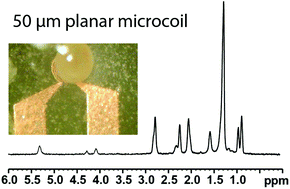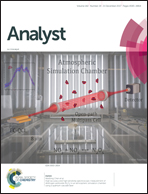Towards single egg toxicity screening using microcoil NMR†
Abstract
Planar microcoils with diameter ranging from 20 to 1000 μm I.D. (130–1130 μm O.D.) are evaluated for their applications in NMR spectroscopy. The coils are first overfilled with a standard sucrose solution and compared against each other. Coils with smaller I.D. (≤100 μm) perform extremely well. One hypothesis is that as the coils get smaller the volume occupied by the copper turns increases relative to the open I.D.; as such a large proportion of the sample is brought in close proximity to the coil turns and likely gives rise to strong sample–coil magnetic coupling, which increases the signal. The applications of the planar microcoils are demonstrated on Cypselurus poecilopterus (fish) and Daphnia magna (water flea) eggs. A single D. magna egg on a 50 μm coil yielded at least 3000 times the mass sensitivity (∼9,000,000 time saving) when compared to a 5 mm probe. This value could be at least 4 times higher if the B1 homogeneity of the coils could be improved. With the current design, 80% of the signal is lost in multiple pulse experiments that rely on phase inversion and signal cancellation between scans. The data were extrapolated to predict that biological samples as small as ∼4 μm may become accessible via planar microcoil designs. To fulfill their potential for in situ metabolic screening, specialized magnetic susceptibility matched sample holders that restrict the sample to the homogeneous B1 field region (i.e. within the 90% RF field) of the coil and advanced experiments that narrow spectral lines, suppress lipids and disperse signals into multiple dimensions will be required.



 Please wait while we load your content...
Please wait while we load your content...